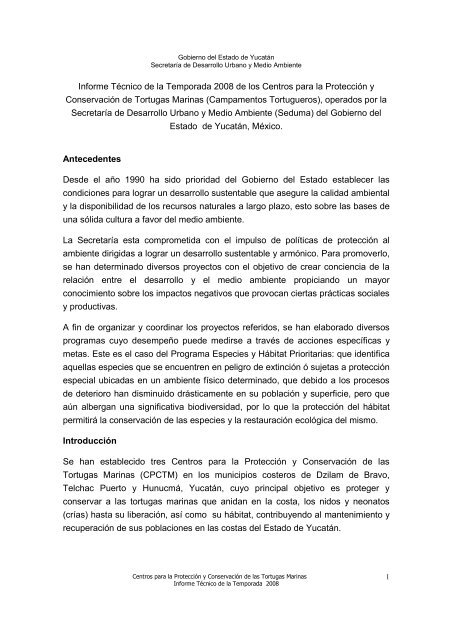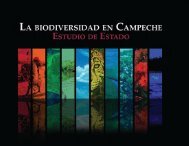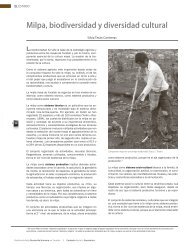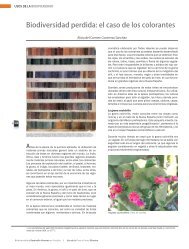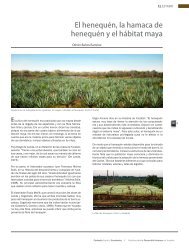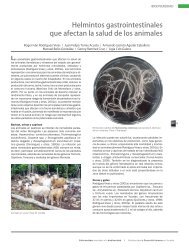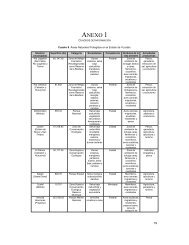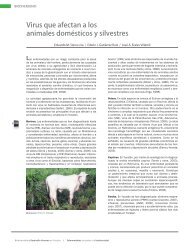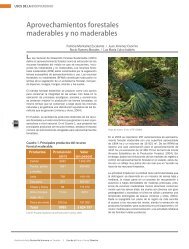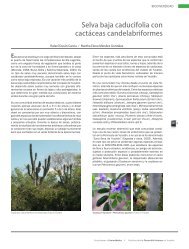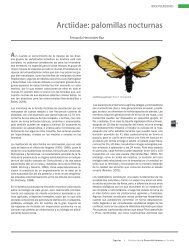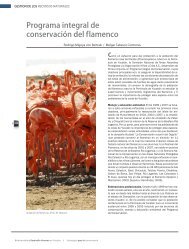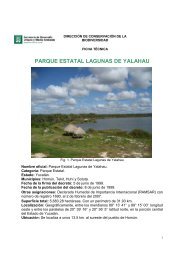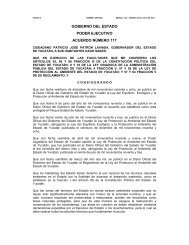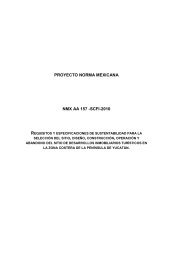Resumen ejecutivo de la temporada 2008 - Secretaría de Desarrollo ...
Resumen ejecutivo de la temporada 2008 - Secretaría de Desarrollo ...
Resumen ejecutivo de la temporada 2008 - Secretaría de Desarrollo ...
Create successful ePaper yourself
Turn your PDF publications into a flip-book with our unique Google optimized e-Paper software.
Gobierno <strong>de</strong>l Estado <strong>de</strong> Yucatán<br />
<strong>Secretaría</strong> <strong>de</strong> <strong>Desarrollo</strong> Urbano y Medio Ambiente<br />
Informe Técnico <strong>de</strong> <strong>la</strong> Temporada <strong>2008</strong> <strong>de</strong> los Centros para <strong>la</strong> Protección y<br />
Conservación <strong>de</strong> Tortugas Marinas (Campamentos Tortugueros), operados por <strong>la</strong><br />
<strong>Secretaría</strong> <strong>de</strong> <strong>Desarrollo</strong> Urbano y Medio Ambiente (Seduma) <strong>de</strong>l Gobierno <strong>de</strong>l<br />
Estado <strong>de</strong> Yucatán, México.<br />
Antece<strong>de</strong>ntes<br />
Des<strong>de</strong> el año 1990 ha sido prioridad <strong>de</strong>l Gobierno <strong>de</strong>l Estado establecer <strong>la</strong>s<br />
condiciones para lograr un <strong>de</strong>sarrollo sustentable que asegure <strong>la</strong> calidad ambiental<br />
y <strong>la</strong> disponibilidad <strong>de</strong> los recursos naturales a <strong>la</strong>rgo p<strong>la</strong>zo, esto sobre <strong>la</strong>s bases <strong>de</strong><br />
una sólida cultura a favor <strong>de</strong>l medio ambiente.<br />
La <strong>Secretaría</strong> esta comprometida con el impulso <strong>de</strong> políticas <strong>de</strong> protección al<br />
ambiente dirigidas a lograr un <strong>de</strong>sarrollo sustentable y armónico. Para promoverlo,<br />
se han <strong>de</strong>terminado diversos proyectos con el objetivo <strong>de</strong> crear conciencia <strong>de</strong> <strong>la</strong><br />
re<strong>la</strong>ción entre el <strong>de</strong>sarrollo y el medio ambiente propiciando un mayor<br />
conocimiento sobre los impactos negativos que provocan ciertas prácticas sociales<br />
y productivas.<br />
A fin <strong>de</strong> organizar y coordinar los proyectos referidos, se han e<strong>la</strong>borado diversos<br />
programas cuyo <strong>de</strong>sempeño pue<strong>de</strong> medirse a través <strong>de</strong> acciones específicas y<br />
metas. Este es el caso <strong>de</strong>l Programa Especies y Hábitat Prioritarias: que i<strong>de</strong>ntifica<br />
aquel<strong>la</strong>s especies que se encuentren en peligro <strong>de</strong> extinción ó sujetas a protección<br />
especial ubicadas en un ambiente físico <strong>de</strong>terminado, que <strong>de</strong>bido a los procesos<br />
<strong>de</strong> <strong>de</strong>terioro han disminuido drásticamente en su pob<strong>la</strong>ción y superficie, pero que<br />
aún albergan una significativa biodiversidad, por lo que <strong>la</strong> protección <strong>de</strong>l hábitat<br />
permitirá <strong>la</strong> conservación <strong>de</strong> <strong>la</strong>s especies y <strong>la</strong> restauración ecológica <strong>de</strong>l mismo.<br />
Introducción<br />
Se han establecido tres Centros para <strong>la</strong> Protección y Conservación <strong>de</strong> <strong>la</strong>s<br />
Tortugas Marinas (CPCTM) en los municipios costeros <strong>de</strong> Dzi<strong>la</strong>m <strong>de</strong> Bravo,<br />
Telchac Puerto y Hunucmá, Yucatán, cuyo principal objetivo es proteger y<br />
conservar a <strong>la</strong>s tortugas marinas que anidan en <strong>la</strong> costa, los nidos y neonatos<br />
(crías) hasta su liberación, así como su hábitat, contribuyendo al mantenimiento y<br />
recuperación <strong>de</strong> sus pob<strong>la</strong>ciones en <strong>la</strong>s costas <strong>de</strong>l Estado <strong>de</strong> Yucatán.<br />
Centros para <strong>la</strong> Protección y Conservación <strong>de</strong> <strong>la</strong>s Tortugas Marinas<br />
Informe Técnico <strong>de</strong> <strong>la</strong> Temporada <strong>2008</strong><br />
1
Gobierno <strong>de</strong>l Estado <strong>de</strong> Yucatán<br />
<strong>Secretaría</strong> <strong>de</strong> <strong>Desarrollo</strong> Urbano y Medio Ambiente<br />
Ubicación <strong>de</strong> los Centros para <strong>la</strong> Protección y <strong>la</strong> Conservación <strong>de</strong> <strong>la</strong> Tortuga<br />
Marina (CPCTM).<br />
El proyecto se realiza en tres áreas diferentes <strong>de</strong> <strong>la</strong> zona costera <strong>de</strong>l estado <strong>de</strong><br />
Yucatán:<br />
La primera se encuentra en <strong>la</strong> zona norocci<strong>de</strong>ntal <strong>de</strong>l Estado, en el municipio <strong>de</strong><br />
Hunucmá en <strong>la</strong> localidad <strong>de</strong> Sisal, que pertenece a <strong>la</strong> Reserva Estatal El Palmar;<br />
ahí se protege principalmente tortuga <strong>de</strong> <strong>la</strong> especie carey (Eretmochelys<br />
imbricata), don<strong>de</strong> se recorren y vigi<strong>la</strong>n alre<strong>de</strong>dor <strong>de</strong> 40 kilómetros <strong>de</strong> p<strong>la</strong>ya y<br />
participan grupos <strong>de</strong> voluntarios, nacionales y extranjeros, realizando <strong>la</strong>s diversas<br />
activida<strong>de</strong>s.<br />
Otra <strong>de</strong> <strong>la</strong>s áreas <strong>de</strong> protección se localiza en <strong>la</strong> parte centro <strong>de</strong> <strong>la</strong> costa <strong>de</strong>l<br />
Estado, en el municipio <strong>de</strong> Telchac Puerto en <strong>la</strong> localidad <strong>de</strong>l mismo nombre y<br />
don<strong>de</strong> se protegen 50 kilómetros <strong>de</strong> costa; también es zona <strong>de</strong> anidación <strong>de</strong><br />
tortuga carey (Eretmochelys imbricada) y <strong>de</strong> algunos ejemp<strong>la</strong>res <strong>de</strong> tortuga b<strong>la</strong>nca<br />
(Chelonia midas); <strong>de</strong> los tres campamentos a cargo <strong>de</strong> <strong>la</strong> SEDUMA, este es el<br />
único que no se encuentra <strong>de</strong>ntro <strong>de</strong> un Área Natural Protegida.<br />
La tercera zona <strong>de</strong>l proyecto se localiza en el municipio <strong>de</strong> Dzi<strong>la</strong>m <strong>de</strong> Bravo, en <strong>la</strong><br />
parte oriente <strong>de</strong>l Estado, es parte <strong>de</strong> <strong>la</strong> Reserva Estatal <strong>de</strong> Dzi<strong>la</strong>m. En este lugar<br />
se protegen 40 kilómetros <strong>de</strong> costa y a diferencia <strong>de</strong> los otros dos campamentos,<br />
en éste, los recorridos <strong>de</strong> protección, se realizan en <strong>la</strong>ncha, mientras que en<br />
Telchac Puerto y El Palmar se realizan con cuatrimotos (cuadro 1, Mapa 1. La<br />
vigencia <strong>de</strong> <strong>la</strong> autorización para operar los tres Campamentos Tortugueros, por<br />
parte <strong>de</strong> <strong>la</strong> SEMARNAT es hasta el 31 <strong>de</strong> mayo <strong>de</strong> 2009.<br />
Localidad<br />
Sisal<br />
Dzi<strong>la</strong>m Bravo<br />
Telchac Puerto<br />
Cuadro 1. Fechas <strong>de</strong> Autorizaciones y Refrendos <strong>de</strong> los Centros <strong>de</strong> Protección<br />
y Conservación <strong>de</strong> <strong>la</strong> Tortuga Marina en el estado <strong>de</strong> Yucatán<br />
Autorización<br />
1er. Refrendo<br />
Oficio <strong>de</strong> Autorización<br />
(C<strong>la</strong>ve y fecha)<br />
INE/DGVS/TM-035-YUC<br />
CONV-DGVS/CPCTM-035-YUC-002 SGPA/DGVS/03301/08<br />
(07-09-1999)<br />
(22-04-2002)<br />
INE/DGVS/TM-040-YUC<br />
CONV-DGVS/CPCTM-040-YUC-002 SGPA/DGVS/03301/08<br />
(13-04-2000)<br />
(22-04-2002)<br />
INE/DGVS/TM-033-YUC<br />
DGVS/CPCTM-033-YUC-05<br />
SGPA/DGVS/03301/08<br />
(20-07-1999)<br />
(12/04/2005)<br />
Centros para <strong>la</strong> Protección y Conservación <strong>de</strong> <strong>la</strong>s Tortugas Marinas<br />
Informe Técnico <strong>de</strong> <strong>la</strong> Temporada <strong>2008</strong><br />
2
Gobierno <strong>de</strong>l Estado <strong>de</strong> Yucatán<br />
<strong>Secretaría</strong> <strong>de</strong> <strong>Desarrollo</strong> Urbano y Medio Ambiente<br />
Estado <strong>de</strong> Yucatán<br />
<strong>2008</strong><br />
Mapa 1. Ubicación <strong>de</strong> los Centros para <strong>la</strong> Protección y Conservación <strong>de</strong> <strong>la</strong> Tortuga Marina (Campamentos<br />
Tortugueros) en el Estado <strong>de</strong> Yucatán.<br />
OBJETIVOS Y METAS<br />
General<br />
Proteger y conservar <strong>la</strong>s pob<strong>la</strong>ciones <strong>de</strong> tortugas marinas que llegan para anidar<br />
a <strong>la</strong>s costas <strong>de</strong>l Estado <strong>de</strong> Yucatán<br />
Específicos<br />
1.- Realizar activida<strong>de</strong>s <strong>de</strong> conservación, educación ambiental, protección y<br />
vigi<strong>la</strong>ncia sobre tortugas marinas en <strong>la</strong>s p<strong>la</strong>yas <strong>de</strong>l Estado <strong>de</strong> Yucatán.<br />
2.- Establecer acciones <strong>de</strong> coordinación interinstitucional en materia <strong>de</strong><br />
conservación, protección, investigación, manejo y divulgación <strong>de</strong> tortugas marinas.<br />
Centros para <strong>la</strong> Protección y Conservación <strong>de</strong> <strong>la</strong>s Tortugas Marinas<br />
Informe Técnico <strong>de</strong> <strong>la</strong> Temporada <strong>2008</strong><br />
3
Gobierno <strong>de</strong>l Estado <strong>de</strong> Yucatán<br />
<strong>Secretaría</strong> <strong>de</strong> <strong>Desarrollo</strong> Urbano y Medio Ambiente<br />
3.- Fortalecer <strong>la</strong>s acciones <strong>de</strong> inspección y vigi<strong>la</strong>ncia en materia <strong>de</strong> tortugas<br />
marinas.<br />
4.- Establecer proyectos <strong>de</strong> diversificación productiva en <strong>la</strong>s zonas <strong>de</strong> influencia <strong>de</strong><br />
los campamentos tortugueros, como alternativa económica <strong>de</strong> <strong>la</strong>s comunida<strong>de</strong>s<br />
locales.<br />
5.- Generar <strong>la</strong>s activida<strong>de</strong>s <strong>de</strong> educación ambiental encaminadas a <strong>la</strong> difusión <strong>de</strong>l<br />
conocimiento, concientización e información dirigida a <strong>la</strong> pob<strong>la</strong>ción en general y<br />
pescadores en particu<strong>la</strong>r, sobre <strong>la</strong> importancia <strong>de</strong> <strong>la</strong>s tortugas marinas.<br />
Metas<br />
1.- Proteger <strong>la</strong>s tortugas anidadoras, nidos y huevos en <strong>la</strong>s áreas <strong>de</strong> influencia <strong>de</strong><br />
los tres CPCTM, así como obtener el 70% <strong>de</strong> <strong>la</strong>s liberaciones <strong>de</strong> neonatos <strong>de</strong><br />
tortugas marinas como mínimo.<br />
2.- Consolidar <strong>la</strong> vigi<strong>la</strong>ncia para eliminar el aprovechamiento ilegal <strong>de</strong> productos y<br />
subproductos <strong>de</strong> tortugas marinas, con <strong>la</strong> participación <strong>de</strong> <strong>la</strong> autoridad <strong>de</strong> los tres<br />
ór<strong>de</strong>nes <strong>de</strong> gobierno y <strong>de</strong>l sector social <strong>de</strong> <strong>la</strong>s localida<strong>de</strong>s costeras.<br />
3. Mantener en operación los tres CPCTM durante <strong>la</strong> <strong>temporada</strong> <strong>de</strong> anidación<br />
2009.<br />
Resultados por CPCTM<br />
CPCTM- Sisal<br />
En Sisal comenzaron los recorridos <strong>la</strong> primera semana <strong>de</strong> Abril, terminándose <strong>la</strong><br />
segunda semana <strong>de</strong> Septiembre, recorriendo aproximadamente 40 kilómetros <strong>de</strong><br />
costa por día, <strong>de</strong> <strong>la</strong>s 20:00 a <strong>la</strong>s 6:00 <strong>de</strong> <strong>la</strong> mañana, realizando 160 salidas en <strong>la</strong>s<br />
que se recorrió un total <strong>de</strong> 6,400 kilómetros.<br />
Se tras<strong>la</strong>daron 102 nidos <strong>de</strong> tortuga carey (Eretmochelys imbricata) (figura 1) <strong>de</strong><br />
los cuales se sembraron 16,215 huevos, liberándose 11,104 crías, con un<br />
porcentaje <strong>de</strong> liberación <strong>de</strong>l 68.48% y un porcentaje <strong>de</strong> sobrevivencia <strong>de</strong>l 71.50%<br />
(cuadro 2).<br />
Se registraron los datos morfométricos <strong>de</strong> 30 hembras adultas, <strong>de</strong> <strong>la</strong>s cuales se<br />
marcaron 24 (cuadro 3). Se realizaron 2 remarcas y 5 recapturas.<br />
Centros para <strong>la</strong> Protección y Conservación <strong>de</strong> <strong>la</strong>s Tortugas Marinas<br />
Informe Técnico <strong>de</strong> <strong>la</strong> Temporada <strong>2008</strong><br />
4
Gobierno <strong>de</strong>l Estado <strong>de</strong> Yucatán<br />
<strong>Secretaría</strong> <strong>de</strong> <strong>Desarrollo</strong> Urbano y Medio Ambiente<br />
Cuadro 2. Resultados <strong>de</strong>l CPCTM-Sisal en <strong>la</strong> <strong>temporada</strong> para Eretmochelys imbricata.<br />
CPCTM<br />
Nº<br />
TOTAL<br />
DE<br />
NIDOS<br />
Nº HUEVOS<br />
EXTRAIDOS<br />
Nº DE HUEVOS<br />
SEMBRADOS<br />
Nº CRÍAS<br />
EMERGIDAS<br />
% DE<br />
SOBREVIV.<br />
EN NIDO<br />
Nº CRÍAS<br />
LIBERADAS<br />
% DE LIBER.<br />
SISAL 102 16,264 16,215 11,608 71.58 11,104 68.48<br />
Nidos<br />
50<br />
40<br />
30<br />
20<br />
33<br />
42<br />
23<br />
10<br />
0<br />
4<br />
MAYO JUNIO JULIO AGOSTO<br />
Mes<br />
Figura 1. Nidos tras<strong>la</strong>dados al corral <strong>de</strong> incubación <strong>de</strong>l CPCTM-Sisal mensualmente<br />
Cuadro 3. Marcas utilizadas en CPCTM- Sisal<br />
Marcas Nuevas en Hembras Anidadoras<br />
MARCAS<br />
MEDIDAS<br />
IZQ. DER. LSCC ASCC<br />
TTV108 TTV109 97 86<br />
TTV111 TTV112 86 83<br />
TTV115<br />
TTV116<br />
TTV117 TTV118 96 89<br />
TTV119 TTV120 91 88<br />
TTV121 TTV122 91 87<br />
TTV123 TTV124 89 86<br />
TTV125 TTV110 92 88<br />
TTV127 TTV126 97 84<br />
TTV128<br />
TTV129<br />
TTV131 TTV130 90 87<br />
TTV133<br />
TTV132<br />
TTV134 TTV135 92 86<br />
TTV136 TTV137 89 79<br />
TTV138 TTV139 92 88<br />
TTV140 TTV141 95 90<br />
TTV142 TTV143 94 93<br />
TTV144 TTV145 97 92<br />
Centros para <strong>la</strong> Protección y Conservación <strong>de</strong> <strong>la</strong>s Tortugas Marinas<br />
Informe Técnico <strong>de</strong> <strong>la</strong> Temporada <strong>2008</strong><br />
5
Gobierno <strong>de</strong>l Estado <strong>de</strong> Yucatán<br />
<strong>Secretaría</strong> <strong>de</strong> <strong>Desarrollo</strong> Urbano y Medio Ambiente<br />
TTV148 TTV147 87 79<br />
TTV149 TTV150 94 87<br />
TTV151<br />
TTV152<br />
TTV154 TTV155 90 83<br />
TTV156 TTV157 91 74<br />
Sin marca Sin marca 100 93<br />
Sin marca Sin marca 88 86<br />
Sin marca Sin marca 92 84<br />
Sin marca Sin marca 106 102<br />
Sin marca Sin marca 98 94<br />
Sin marca Sin marca 89 85<br />
Sin marca Sin marca 92 86<br />
Sin marca Sin marca 95 86<br />
Sin marca Sin marca 92 82<br />
Remarcas y Recapturas <strong>de</strong> hembras andantes<br />
FM817 TTV146 93 87<br />
TTV131 TTV130 90 87<br />
TTV133<br />
TTV132<br />
TTV113 FM855 90 92<br />
TTV134 TTV135 92 86<br />
CPCTM- Telchac Puerto<br />
En este campamento los recorridos dieron inicio <strong>la</strong> primera semana <strong>de</strong> Mayo y<br />
terminaron <strong>la</strong> primera semana <strong>de</strong> noviembre.<br />
Se protegieron 50 kilómetros <strong>de</strong> p<strong>la</strong>ya aproximadamente rumbo al puerto <strong>de</strong><br />
Progreso. Aquí los recorridos se realizaron <strong>de</strong> <strong>la</strong>s 20:00 horas hasta <strong>la</strong>s 4:00 <strong>de</strong> <strong>la</strong><br />
mañana; en total fueron 96 salidas con 3,840 kilómetros recorridos.<br />
Respecto a <strong>la</strong> tortuga carey, (Eretmochelys imbricata), se tras<strong>la</strong>daron al corral 32<br />
nidos (cuadro 4) con 4,724 huevos sembrados en total, liberándose 3,168 crías,<br />
con un porcentaje <strong>de</strong> liberación <strong>de</strong>l 67.33% y un porcentaje <strong>de</strong> sobrevivencia <strong>de</strong><br />
67.89 %.<br />
Respecto a <strong>la</strong> tortuga b<strong>la</strong>nca, (Chelonia mydas), se tras<strong>la</strong>daron al corral 6 nidos<br />
(cuadro 5) con 809 huevos sembrados en total, liberándose 338 crías, con un<br />
porcentaje <strong>de</strong> liberación <strong>de</strong>l 41.78 % y un porcentaje <strong>de</strong> sobrevivencia <strong>de</strong> 42.52 %.<br />
Se tras<strong>la</strong>daron 38 nidos <strong>de</strong> ambas especies (figura 2)<br />
Se registraron los datos morfométricos <strong>de</strong> 9 hembras anidadoras, <strong>de</strong> <strong>la</strong>s cuales se<br />
marcaron 3. (cuadro 6).<br />
Centros para <strong>la</strong> Protección y Conservación <strong>de</strong> <strong>la</strong>s Tortugas Marinas<br />
Informe Técnico <strong>de</strong> <strong>la</strong> Temporada <strong>2008</strong><br />
6
Gobierno <strong>de</strong>l Estado <strong>de</strong> Yucatán<br />
<strong>Secretaría</strong> <strong>de</strong> <strong>Desarrollo</strong> Urbano y Medio Ambiente<br />
Cuadro 4. Resultados <strong>de</strong>l CPCTM-Telchac Puerto en <strong>la</strong> <strong>temporada</strong> para Eretmochelys imbricata.<br />
CPCTM<br />
Nº<br />
TOTAL<br />
DE<br />
NIDOS<br />
Nº HUEVOS<br />
EXTRAIDOS<br />
Nº DE HUEVOS<br />
SEMBRADOS<br />
Nº CRÍAS<br />
EMERGIDAS<br />
% DE<br />
SOBREVIV.<br />
EN NIDO<br />
Nº CRÍAS<br />
LIBERADAS<br />
% DE LIBER.<br />
TELCHAC 32 4,724 4,706 3,195 67.89 3,168 67.33<br />
Cuadro 5. Resultados <strong>de</strong>l CPCTM-Telchac Puerto en <strong>la</strong> <strong>temporada</strong> para Chelonia mydas.<br />
CPCTM<br />
Nº<br />
TOTAL<br />
DE<br />
NIDOS<br />
Nº HUEVOS<br />
EXTRAIDOS<br />
Nº DE HUEVOS<br />
SEMBRADOS<br />
Nº CRÍAS<br />
EMERGIDAS<br />
% DE<br />
SOBREVIV.<br />
EN NIDO<br />
Nº CRÍAS<br />
LIBERADAS<br />
% DE LIBER.<br />
TELCHAC 6 813 809 344 42.52 338 41.78<br />
Nidos<br />
30<br />
25<br />
20<br />
15<br />
10<br />
5<br />
0<br />
24<br />
9<br />
3<br />
2<br />
JUNIO JULIO AGOSTO SEPTIEMBRE<br />
Mes<br />
Figura 2. Nidos tras<strong>la</strong>dados al corral <strong>de</strong> incubación <strong>de</strong>l CPCTM-Telchac Puerto mensualmente.<br />
Cuadro 6. Medidas y Marcas utilizadas en CPCTM- Telchac puerto<br />
Marcas Nuevas en Hembras Anidadoras<br />
MARCAS<br />
MEDIDAS (cm)<br />
IZQ. DER. LSCC ASCC<br />
Sin marca EGO71 128 115<br />
EGO72 Sin marca 81 89<br />
EGO73 Sin marca 117 109<br />
Centros para <strong>la</strong> Protección y Conservación <strong>de</strong> <strong>la</strong>s Tortugas Marinas<br />
Informe Técnico <strong>de</strong> <strong>la</strong> Temporada <strong>2008</strong><br />
7
Gobierno <strong>de</strong>l Estado <strong>de</strong> Yucatán<br />
<strong>Secretaría</strong> <strong>de</strong> <strong>Desarrollo</strong> Urbano y Medio Ambiente<br />
Sin marca Sin marca 92 81<br />
Sin marca Sin marca 88 80<br />
Sin marca Sin marca 85 81<br />
Sin marca Sin marca 98 86<br />
Sin marca Sin marca 98 84<br />
Sin marca Sin marca 109 96<br />
CPCTM-Dzi<strong>la</strong>m <strong>de</strong> Bravo<br />
En Dzi<strong>la</strong>m <strong>de</strong> Bravo se comenzaron los recorridos <strong>de</strong> inspección y vigi<strong>la</strong>ncia <strong>la</strong><br />
segunda semana <strong>de</strong> Abril y finalizaron <strong>la</strong> primera semana <strong>de</strong> Octubre.<br />
Se recorrieron 40 kilómetros aproximadamente rumbo al faro <strong>de</strong> Yalkubul. Los<br />
recorridos se realizaron <strong>de</strong> <strong>la</strong>s 22:00 horas a <strong>la</strong>s 6:00 horas <strong>de</strong> <strong>la</strong> mañana; en total<br />
fueron 80 salidas, con un total <strong>de</strong> 3,200 kilómetros recorridos.<br />
Respecto a <strong>la</strong> tortuga carey, (Eretmochelys imbricata), se tras<strong>la</strong>daron al corral 58<br />
nidos (cuadro 7) con 9,160 huevos sembrados en total, liberándose 5,381 crías,<br />
con un porcentaje <strong>de</strong> liberación <strong>de</strong>l 58.74 % y un porcentaje <strong>de</strong> sobrevivencia <strong>de</strong><br />
60.49 %.<br />
Respecto a <strong>la</strong> tortuga b<strong>la</strong>nca, (Chelonia mydas), se tras<strong>la</strong>dó al corral 1 nido<br />
(cuadro 8) con 120 huevos sembrados en total, liberándose 96 crías, con un<br />
porcentaje <strong>de</strong> liberación <strong>de</strong>l 80 % y un porcentaje <strong>de</strong> sobrevivencia <strong>de</strong> 80 %.<br />
Se tras<strong>la</strong>daron 59 nidos <strong>de</strong> ambas especies (figura 3).<br />
En este campamento, no se registraron datos morfométricos, ni marcaje.<br />
Cuadro 7. Resultados <strong>de</strong>l CPCTM-Dzi<strong>la</strong>m <strong>de</strong> Bravo en <strong>la</strong> <strong>temporada</strong> para Eretmochelys imbricata.<br />
CPCTM<br />
Nº<br />
TOTAL<br />
DE<br />
NIDOS<br />
Nº HUEVOS<br />
EXTRAIDOS<br />
Nº DE<br />
HUEVOS<br />
SEMBRADOS<br />
Nº CRÍAS<br />
EMERGIDAS<br />
% DE<br />
SOBREVIV.<br />
EN NIDO<br />
Nº CRÍAS<br />
LIBERADAS<br />
% DE<br />
LIBER.<br />
NIDOS<br />
IN SITU<br />
DZILAM 58 9,187 9,160 5,541 60.49 5,381 58.74 19<br />
Cuadro 8. Resultados <strong>de</strong>l CPCTM-Dzi<strong>la</strong>m <strong>de</strong> Bravo en <strong>la</strong> <strong>temporada</strong> para Chelonia mydas.<br />
CPCTM<br />
Nº<br />
TOTAL<br />
DE<br />
NIDOS<br />
Nº HUEVOS<br />
EXTRAIDOS<br />
Nº DE<br />
HUEVOS<br />
SEMBRADOS<br />
Nº CRÍAS<br />
EMERGIDAS<br />
% DE<br />
SOBREVIV.<br />
EN NIDO<br />
Nº CRÍAS<br />
LIBERADAS<br />
% DE<br />
LIBER.<br />
DZILAM 1 124 120 96 80.00 96 80.00<br />
Centros para <strong>la</strong> Protección y Conservación <strong>de</strong> <strong>la</strong>s Tortugas Marinas<br />
Informe Técnico <strong>de</strong> <strong>la</strong> Temporada <strong>2008</strong><br />
8
Gobierno <strong>de</strong>l Estado <strong>de</strong> Yucatán<br />
<strong>Secretaría</strong> <strong>de</strong> <strong>Desarrollo</strong> Urbano y Medio Ambiente<br />
30<br />
25<br />
24<br />
20<br />
18<br />
Nidos<br />
15<br />
10<br />
14<br />
5<br />
0<br />
MAYO JUNIO JULIO AGOSTO<br />
3<br />
Mes<br />
Figura 3. Nidos tras<strong>la</strong>dados al corral <strong>de</strong> incubación <strong>de</strong>l CPCTM-Dzi<strong>la</strong>m <strong>de</strong> Bravo mensualmente.<br />
Resultados globales<br />
Entre ambas especies, se tras<strong>la</strong>daron a los corrales <strong>de</strong> incubación 199 nidos<br />
(figura 4), con un total <strong>de</strong> 31,010 huevos sembrados, emergieron 20,769 neonatos<br />
(entre vivas y muertas antes <strong>de</strong> ser liberadas) y se logró liberar al mar un total <strong>de</strong><br />
20,087 crías (figura 5).<br />
De esta forma se logró un porcentaje sobrevivencia en nido <strong>de</strong>l 66.98% y <strong>de</strong><br />
liberación general <strong>de</strong>l 64.78%.(figura 6). Se tomaron los datos morfométricos en<br />
total <strong>de</strong> 41 hembras anidantes, <strong>de</strong> <strong>la</strong>s cuales se marcaron 31 (cuadro 9).<br />
120<br />
100<br />
102<br />
Nidos<br />
80<br />
60<br />
40<br />
59<br />
38<br />
20<br />
0<br />
SISAL DZILAM TELCHAC<br />
Campamentos<br />
Figura 4 Nidos tras<strong>la</strong>dados a los corrales <strong>de</strong> incubación en <strong>la</strong> <strong>temporada</strong>.<br />
Centros para <strong>la</strong> Protección y Conservación <strong>de</strong> <strong>la</strong>s Tortugas Marinas<br />
Informe Técnico <strong>de</strong> <strong>la</strong> Temporada <strong>2008</strong><br />
9
Gobierno <strong>de</strong>l Estado <strong>de</strong> Yucatán<br />
<strong>Secretaría</strong> <strong>de</strong> <strong>Desarrollo</strong> Urbano y Medio Ambiente<br />
Número<br />
20,000<br />
15,000<br />
10,000<br />
5,000<br />
16,215<br />
9,160<br />
4,706<br />
11,593<br />
5,541<br />
3,195<br />
11,104<br />
5,381<br />
3,168<br />
SISAL<br />
DZILAM<br />
TELCHAC<br />
0<br />
Nº DE HUEVOS<br />
SEMBRADOS<br />
Nº CRÍAS EMERGIDAS Nº CRÍAS LIBERADAS<br />
Actividad<br />
Figura 5. Huevos sembrados, crías emergidas y crías liberadas totales en <strong>la</strong> <strong>temporada</strong> en cada CPCTM.<br />
Cuadro 9. Total <strong>de</strong> Hembras marcadas y registradas en <strong>la</strong> <strong>temporada</strong> <strong>2008</strong>.<br />
Hembras<br />
Campamentos Medidas<br />
Hembras<br />
Marcadas<br />
SISAL 32 28<br />
DZILAM 0 0<br />
TELCHAC 9 3<br />
TOTALES 41 31<br />
80.00<br />
70.00<br />
60.00<br />
71.50<br />
68.48<br />
60.74 64.17 63.57<br />
59.02<br />
50.00<br />
%<br />
40.00<br />
30.00<br />
20.00<br />
% DE SOBREVIVENCIA<br />
EN NIDO<br />
% DE LIBERACIÓN<br />
10.00<br />
0.00<br />
SISAL DZILAM TELCHAC<br />
Campamentos<br />
Figura 6. Porcentaje <strong>de</strong> sobrevivencia en los campamentos <strong>de</strong> <strong>la</strong> <strong>temporada</strong>.<br />
Centros para <strong>la</strong> Protección y Conservación <strong>de</strong> <strong>la</strong>s Tortugas Marinas<br />
Informe Técnico <strong>de</strong> <strong>la</strong> Temporada <strong>2008</strong><br />
10
Gobierno <strong>de</strong>l Estado <strong>de</strong> Yucatán<br />
<strong>Secretaría</strong> <strong>de</strong> <strong>Desarrollo</strong> Urbano y Medio Ambiente<br />
Se realizaron un total <strong>de</strong> 336 recorridos <strong>de</strong> monitoreo (Cuadro 10), con 13,440 km.<br />
recorridos en los 130 kilómetros <strong>de</strong> p<strong>la</strong>ya que abarcan los tres centros <strong>de</strong><br />
protección (figura 7).<br />
Cuadro 10. Número Total <strong>de</strong> Recorridos y Kilómetros Recorridos por Campamento en <strong>la</strong> <strong>temporada</strong> <strong>2008</strong>.<br />
Campamentos<br />
Número total<br />
<strong>de</strong> recorridos<br />
Kilómetros<br />
recorridos<br />
Sisal 160 6,400<br />
Telchac Puerto 96 3,840<br />
Dzi<strong>la</strong>m <strong>de</strong> Bravo 80 3,200<br />
Total 336 13,440<br />
7,000<br />
6,000<br />
6,400<br />
Km. recorridos<br />
5,000<br />
4,000<br />
3,000<br />
2,000<br />
3,840<br />
3,200<br />
1,000<br />
0<br />
Sisal Telchac Puerto Dzi<strong>la</strong>m <strong>de</strong> Bravo<br />
Campamentos<br />
Figura 7. Número <strong>de</strong> kilómetros recorridos en los CPCTM en <strong>la</strong> <strong>temporada</strong>.<br />
Es importante mencionar que se registraron 71 nidos in situ, en los tres<br />
campamentos, obteniéndose los siguientes resultados (cuadro 11):<br />
Sisal:<br />
De los 36 nidos que se <strong>de</strong>jaron in situ, 6 fueron <strong>de</strong>predados por fauna, 2 nidos se<br />
pudrieron los huevos en su totalidad, 9 nidos fueron perdidos por el oleaje tan<br />
fuerte ocasionado por el paso <strong>de</strong>l huracán Ike, <strong>de</strong> los 19 nidos restantes al realizar<br />
el análisis residual <strong>de</strong> los nidos se calculó que 2,665 huevos fueron <strong>de</strong>positados,<br />
<strong>de</strong> los cuales 571 huevos fueron infértiles, 236 crías murieron <strong>de</strong>ntro <strong>de</strong> los nidos y<br />
se liberaron 1,857 crías al mar, en total se obtuvo un 71% <strong>de</strong> sobrevivencia en<br />
nido y 70% <strong>de</strong> liberación.<br />
Centros para <strong>la</strong> Protección y Conservación <strong>de</strong> <strong>la</strong>s Tortugas Marinas<br />
Informe Técnico <strong>de</strong> <strong>la</strong> Temporada <strong>2008</strong><br />
11
Gobierno <strong>de</strong>l Estado <strong>de</strong> Yucatán<br />
<strong>Secretaría</strong> <strong>de</strong> <strong>Desarrollo</strong> Urbano y Medio Ambiente<br />
Dzi<strong>la</strong>m <strong>de</strong> Bravo:<br />
De los 19 nidos que se <strong>de</strong>jaron in situ, 4 fueron <strong>de</strong>predados por fauna, 2 fueron<br />
<strong>de</strong>predados por humano, 11 nidos fueron perdidos por el oleaje tan fuerte<br />
ocasionado por el paso <strong>de</strong>l huracán Ike, <strong>de</strong> los 2 nidos restantes al realizar el<br />
análisis residual <strong>de</strong> los nidos se calculó que 70 huevos fueron <strong>de</strong>positados, <strong>de</strong> los<br />
cuales 7 huevos fueron infértiles, 2 crías murieron <strong>de</strong>ntro <strong>de</strong> los nidos y se<br />
liberaron 65 crías al mar, en total se obtuvo un 93% <strong>de</strong> sobrevivencia en nido y<br />
93% <strong>de</strong> liberación.<br />
Telchac Puerto:<br />
De los 16 nidos que se <strong>de</strong>jaron in situ, 3 fueron <strong>de</strong>predados por fauna, 6 nidos<br />
fueron perdidos por el oleaje tan fuerte ocasionado por el paso <strong>de</strong>l huracán Ike, <strong>de</strong><br />
los 7 nidos restantes al realizar el análisis residual <strong>de</strong> los nidos se calculó que 404<br />
huevos fueron <strong>de</strong>positados, <strong>de</strong> los cuales 59 huevos fueron infértiles y se liberaron<br />
345 crías al mar, en total se obtuvo un 71% <strong>de</strong> sobrevivencia en nido y 70% <strong>de</strong><br />
liberación.<br />
CPCTM<br />
Nº<br />
TOTAL<br />
DE<br />
NIDOS<br />
Cuadro 11.- Resultados globales <strong>de</strong> los tres centros <strong>de</strong> los nidos in situ<br />
Nº<br />
CASCARONES<br />
Nº HUEVOS<br />
INFERTILES<br />
CALCULO DE<br />
HUEVOS<br />
DEPOSITADOS<br />
% DE<br />
SOBREVIVENCIA<br />
EN NIDO<br />
Nº CRÍAS<br />
EMERGIDAS<br />
% DE<br />
LIBERACIÓN<br />
Nº CRÍAS<br />
LIBERADAS<br />
SISAL 36 2,209 571 2,780 68 1,888 67 1,857<br />
DZILAM 19 67 7 74 88 65 88 65<br />
TELCHAC 16 345 59 404 85 345 85 345<br />
TOTALES 71 2,621 637 3,258 71 2,298 70 2,267<br />
Centros para <strong>la</strong> Protección y Conservación <strong>de</strong> <strong>la</strong>s Tortugas Marinas<br />
Informe Técnico <strong>de</strong> <strong>la</strong> Temporada <strong>2008</strong><br />
12
Gobierno <strong>de</strong>l Estado <strong>de</strong> Yucatán<br />
<strong>Secretaría</strong> <strong>de</strong> <strong>Desarrollo</strong> Urbano y Medio Ambiente<br />
Conclusiones<br />
Esta <strong>temporada</strong> marcó una diferencia en comparación con <strong>la</strong> <strong>temporada</strong> anterior,<br />
<strong>de</strong>bido a que el número <strong>de</strong> nidos que se tras<strong>la</strong>daron fue <strong>de</strong> 199 comparado con <strong>la</strong><br />
<strong>temporada</strong> 2007 (96 nidos), sumando los nidos in situ en total se registraron 270<br />
nidos en <strong>la</strong> <strong>temporada</strong> (cuadro 12).<br />
Se notó que <strong>la</strong>s tortugas anidadoras, al menos para <strong>la</strong>s zonas que compren<strong>de</strong>n<br />
nuestros campamentos, tuvieron un atraso <strong>de</strong> aproximadamente un mes, ya que<br />
por lo regu<strong>la</strong>r arriban en el mes <strong>de</strong> abril y en esta ocasión inició en el mes <strong>de</strong><br />
mayo, tendremos que esperar a <strong>la</strong> próxima <strong>temporada</strong> <strong>de</strong> anidamiento para saber<br />
si esto fue ocasionado por factores ambientales o biológicos <strong>de</strong> <strong>la</strong> especie.<br />
El porcentaje <strong>de</strong> sobrevivencia tuvo una caída por <strong>de</strong>bajo <strong>de</strong>l 70% (66.98%) en los<br />
tres centros, con lo que estuvimos por <strong>de</strong>bajo <strong>de</strong>l objetivo p<strong>la</strong>nteado al inicio <strong>de</strong> <strong>la</strong><br />
<strong>temporada</strong>, por lo cual el porcentaje <strong>de</strong> liberación tampoco alcanzó el objetivo<br />
fijado.<br />
Cabe mencionar que en los tres campamentos se presentó <strong>la</strong> marea alta por el<br />
paso <strong>de</strong>l Huracán Ike, el cual afectó a nidos que se encontraban ex situ e in situ,<br />
ya que fueron inundados <strong>de</strong>bido al oleaje tan fuerte; sin embargo los nidos que se<br />
perdieron por este factor ambiental no se están eliminando <strong>de</strong> <strong>la</strong>s tab<strong>la</strong>s, ya que<br />
esta situación ilustra el porque <strong>de</strong> los bajos porcentajes <strong>de</strong> sobrevivencia y<br />
liberación.<br />
Se impartieron 62 pláticas <strong>de</strong> educación ambiental y <strong>de</strong> conservación <strong>de</strong> <strong>la</strong>s<br />
tortugas marinas, atendiendo a un total <strong>de</strong> 1,750 personas aproximadamente.<br />
Centros para <strong>la</strong> Protección y Conservación <strong>de</strong> <strong>la</strong>s Tortugas Marinas<br />
Informe Técnico <strong>de</strong> <strong>la</strong> Temporada <strong>2008</strong><br />
13
Gobierno <strong>de</strong>l Estado <strong>de</strong> Yucatán<br />
<strong>Secretaría</strong> <strong>de</strong> <strong>Desarrollo</strong> Urbano y Medio Ambiente<br />
Literatura citada<br />
Centro <strong>de</strong> Educación Ambiental y Fondo para el Rescate <strong>de</strong> <strong>la</strong> Tortuga Marina<br />
http://www.animales-en-extincion.com/tortuga-marina.html (Vi:3 <strong>de</strong> octubre <strong>de</strong><br />
2006)<br />
http://www.tortugamarina.com/in<strong>de</strong>x.html (Vi:3 <strong>de</strong> octubre <strong>de</strong> 2006)<br />
http://www.umich.mx/varios/tortuga/historia.html (VI:3 <strong>de</strong> octubre <strong>de</strong> 2006)<br />
NOAA(National Oceanic and Atmospheric Administration Servicio <strong>de</strong> Pesca y Vida<br />
Silvestre <strong>de</strong> U.S.A<br />
P<strong>la</strong>n estatal <strong>de</strong> <strong>Desarrollo</strong> <strong>de</strong>l Gobierno <strong>de</strong>l estado <strong>de</strong> Yucatán 2001-2007.<br />
Programa Estatal <strong>de</strong> Medio Ambiente, 2001-2007. 2004. En: Diario Oficial <strong>de</strong> <strong>la</strong><br />
Fe<strong>de</strong>ración, Año CVII, No. 30,162.<br />
Técnicos Responsables:<br />
MVZ Mén<strong>de</strong>z González Luis<br />
MC Echeverría García Adán<br />
Biol. Quesada Dominguez C<strong>la</strong>udia<br />
Antrop. Torres Burgos Erik<br />
Co<strong>la</strong>boradores:<br />
Un agra<strong>de</strong>cimiento especial por el apoyo <strong>de</strong> los Técnicos en Campo:<br />
Sisal: Antolina Ba<strong>la</strong>m, Genaro Cob y Víctor Puc.<br />
Dzi<strong>la</strong>m <strong>de</strong> Bravo: Javier Nadal y Manuel Nadal<br />
Centros para <strong>la</strong> Protección y Conservación <strong>de</strong> <strong>la</strong>s Tortugas Marinas<br />
Informe Técnico <strong>de</strong> <strong>la</strong> Temporada <strong>2008</strong><br />
14
Anexo Fotográfico<br />
Gobierno <strong>de</strong>l Estado <strong>de</strong> Yucatán<br />
<strong>Secretaría</strong> <strong>de</strong> <strong>Desarrollo</strong> Urbano y Medio Ambiente<br />
Tortuga carey (Eretmochelys imbricata)<br />
Tortuga b<strong>la</strong>nca (Chelonia mydas)<br />
Monitoreo <strong>de</strong> hembra anidante<br />
Desenterrando el nido para su tras<strong>la</strong>do al<br />
corral <strong>de</strong> incubación.<br />
Tras<strong>la</strong>do <strong>de</strong> huevos a corral <strong>de</strong> incubación<br />
Siembra <strong>de</strong> huevos en corral <strong>de</strong> incubación<br />
Centros para <strong>la</strong> Protección y Conservación <strong>de</strong> <strong>la</strong>s Tortugas Marinas<br />
Informe Técnico <strong>de</strong> <strong>la</strong> Temporada <strong>2008</strong><br />
15
Gobierno <strong>de</strong>l Estado <strong>de</strong> Yucatán<br />
<strong>Secretaría</strong> <strong>de</strong> <strong>Desarrollo</strong> Urbano y Medio Ambiente<br />
Crías <strong>de</strong> tortuga <strong>de</strong> carey (Eretmochelys<br />
imbricata) emergiendo <strong>de</strong>l nido.<br />
Liberación <strong>de</strong> crías en evento <strong>de</strong> educación<br />
ambiental.<br />
Centros para <strong>la</strong> Protección y Conservación <strong>de</strong> <strong>la</strong>s Tortugas Marinas<br />
Informe Técnico <strong>de</strong> <strong>la</strong> Temporada <strong>2008</strong><br />
16
Gobierno <strong>de</strong>l Estado <strong>de</strong> Yucatán<br />
<strong>Secretaría</strong> <strong>de</strong> <strong>Desarrollo</strong> Urbano y Medio Ambiente<br />
Cuadro 12.- Resultados globales <strong>de</strong> los tres centros <strong>de</strong> los nidos ex situ<br />
CPCTM<br />
Nº TOTAL DE NIDOS EN<br />
EL CORRAL DE<br />
INCUBACIÓN<br />
Nº HUEVOS<br />
EXTRAIDOS<br />
Nº HUEVOS<br />
ROTOS<br />
Nº DE HUEVOS<br />
SEMBRADOS<br />
Nº DE HUEVOS SIN<br />
ECLOSIONAR<br />
% DE<br />
SOBREVIVENCIA EN<br />
NIDO<br />
Nº CRÍAS<br />
EMERGIDAS<br />
Nº CRÍAS<br />
MUERTAS<br />
% DE<br />
LIBERACIÓN<br />
SISAL 102 16,264 49 16,215 4,607 71.58 11,608 504 68.48 11,104<br />
DZILAM 59 9,311 31 9,280 3,643 60.74 5,637 160 59.02 5,477<br />
TELCHAC 38 5,537 22 5,515 1,976 64.17 3,539 33 63.57 3,506<br />
Nº CRÍAS<br />
LIBERADAS<br />
TOTALES 199 31,112 102 31,010 10,226 66.98 20,784 697 64.78 20,087<br />
Centros para <strong>la</strong> Protección y Conservación <strong>de</strong> <strong>la</strong>s Tortugas Marinas<br />
Informe Técnico <strong>de</strong> <strong>la</strong> Temporada <strong>2008</strong><br />
17


